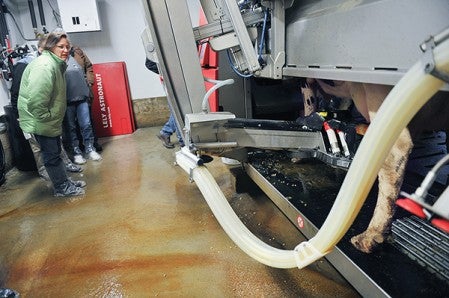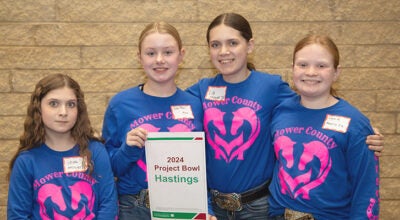Ambling around agriculture: Agribusiness tour offers plenty of education
Published 10:27 am Friday, April 12, 2013
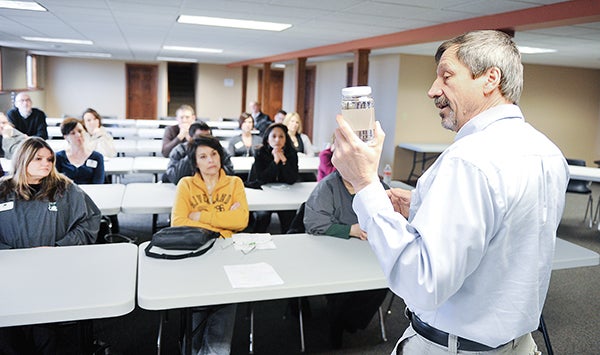
Don Burns, commodities specialist for Absolute Energy, holds up a jar of pure ethanol during a presentation to Leadership Austin Thursday morning at the ethanol plant just south of Lyle. — Eric Johnson/photodesk@austindailyherald.com
People focused on a little mason jar of clear liquid as Don Burns raised it above his head.
Of course, many were thinking the same thing as they looked at each other, but no, it was not moonshine. The crowd chuckled.
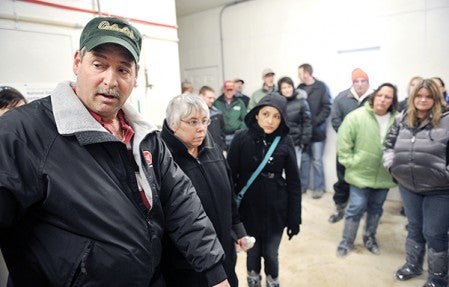
Brian Miller takes visitors from Leadership Austin through his milking operation, showing them his temporary milk holding setup Thursday at his farm south of Adams.
“This is ethanol,” said Burns, the commodities specialist at Absolute Energy’s ethanol plant just outside Lyle. “This is what we ship out of here.”
For the group of 17 eager learners, it was indeed an educational tour on Leadership Austin’s Agriculture and Agribusiness Day. The tour was one of the last of the school year for those in the Leadership Austin program, coordinated between Riverland Community College and the Austin Area Chamber of Commerce. In the past months, the participants learned about health care, law enforcement and local government as they moved toward earning a certificate of completion and three college credits.
Thursday’s tour not only showcased the newest in agricultural technology, but how tightly knit each sector of agribusiness is within Mower County.
“OK, we have time for one more question …,” Chamber Director Sandy Forstner said as he tried to keep the tour on schedule.
But the group was enthralled with ethanol: the process of making it, why it’s put in America’s fuel, who determines the price and how much money Absolute Energy makes. So they asked more questions.
Burns belted out numbers, such as 100 million, the number of gallons of ethanol the Lyle plant produces each year from 40 million bushels of corn. Sixteen cents, the amount of profit for Absolute Energy on each gallon. Sixty-eight million, the dollars farmers and investors pitched in to start the Lyle plant.
Burns said about 500 area farmers sell corn to Absolute each year, and the company just surpassed the $1 billion mark in payouts for corn.
“We figure that added about 5 to 10 cents to the market by us being here,” Burns said, who explained how the ethanol plant pays more because it competes to purchase corn that could potentially be contracted for more money. The plant is constantly buying, grinding and heating corn into fuel.
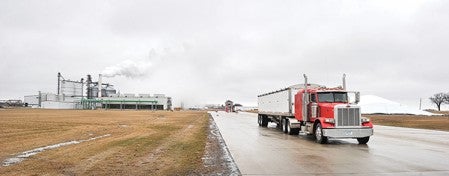
A semi leaves the Absolute Energy ethanol plant south of Lyle Thursday morning. The plant was one of four stops for Leadership Austin Thursday.
Several minutes later, Angie Stout turned her head nearly upside down to see why lasers were beaming at teats on a cow at Brian Miller’s dairy farm near Adams. Just moments earlier, another milking rotation started, even though nobody was in the barn. A computer handled the work while cows waited, some not so patiently, in line.
“It’s amazing — from when I was a little girl seeing my uncle milk cows to the way they are doing it now,” said Stout, who stood like the rest of the group in plastic boot protectors.
Others were fascinated by the technology, as well. Though robot milkers have been available since 1992, not many in the group had seen one in action. And clearly, the technology has improved. A laser guided system cleaned each cow’s udder, recognized each cow by number, recorded that cow’s milk production in a computer, finished milking and opened the gate for another one to move in.
Gregg Luebke of Dairyland Equipment Services, who sells such units, explained how about 16 farms in southeastern Minnesota now use this type of technology. While the Miller farm has one robot, which can handle about 60 to 70 cows in one milking rotation, many farms have two or more.
The information was interesting for Austin High School activities director Lisa Quednow-Bickler, who oversees the robotics program. After Thursday, she could relay practical, positive information to her students. Cutting-edge robotics are out there, and they’re in Mower County.
“It’s fun to see the application,” Quednow-Bickler said. “It’s neat to see what it takes to build a community. You have to have leaders in agriculture … and keep our area competitive in the nation.”
For farmers like Miller, it’s a chance to get the real story of agriculture circulating, too. Miller has been on similar tours, and he wanted to return the favor. When Leadership Austin reps called, he said “yes.”
“I think it’s important for the public to know what’s going on at these farms,” Miller said. “Just so they can have an understanding. So they can see the animal health.”
As the tour left the Miller farm, they prepared to see more technology at a hog farm. They had already toured a grain farm earlier that day, and all their experiences would serve them well, another member of the tour said. Someday, they’ll reflect on these experiences and be able to say they know the details. They know just how closely every cog in the economic wheel is connected, even within one county.


